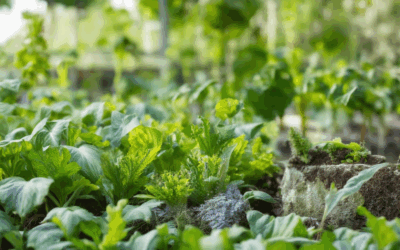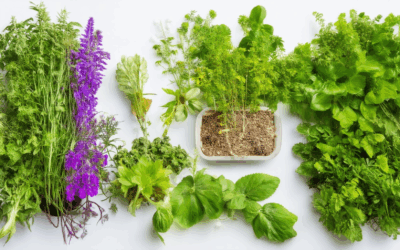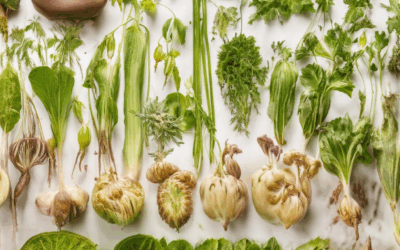Gardening is a rewarding endeavor that brings joy and fresh produce to your life, but did you know that one simple practice can drastically improve your yields and garden health? Crop rotation, a method of growing different types of plants in sequence, is often overlooked yet remains one of the most effective ways to maintain soil fertility, reduce pests, and minimize diseases. By understanding the best practices for garden crop rotation, you can create a thriving, productive vegetable garden that withstands seasonal challenges and thrives for years to come. Whether you’re new to gardening or looking to refine your skills, this guide offers a clear, step-by-step approach to designing and implementing an effective crop rotation plan tailored to your vegetable garden. From selecting the right crops to overcoming common misconceptions, we’ll explore everything you need to know to master garden crop rotation and enjoy a bountiful harvest year after year.
Best Order for Crop Rotation
Crop rotation is a vital aspect of sustainable farming and gardening, helping to maintain soil health, reduce pests, and improve plant yields. The optimal order for crop rotation depends on several factors, including the type of crops grown, soil condition, and regional climate. Below is a comprehensive guide to determining the best crop rotation sequence.
Understanding Crop Groups
Crops can be categorized into groups based on their nutrient requirements and growth habits:
- Legumes : Plants like beans, peas, and alfalfa are excellent starters in a rotation plan. They fix nitrogen in the soil, enriching it for subsequent crops.
- Leafy Greens : Vegetables such as lettuce, spinach, and kale are shallow-rooted and benefit from being planted after legumes.
- Fruiting Crops : Tomatoes, peppers, and eggplants require substantial nutrients and should follow legumes or leafy greens to replenish the soil.
- Root Crops : Carrots, beets, and radishes improve soil structure and are ideal to grow after fruiting crops.
Why Crop Rotation Matters
- Soil Health : Rotating crops prevents soil degradation and maintains essential nutrients.
- Pest Control : Different crops attract different pests, reducing the need for chemical treatments.
- Yield Improvement : A well-planned rotation can increase crop productivity and reduce losses.
Sample Crop Rotation Plan
Following a 4-step rotation plan can work well:1. Legumes (e.g., beans, peas) → Leafy Greens (e.g., lettuce, spinach) → Fruiting Crops (e.g., tomatoes, peppers) → Root Crops (e.g., carrots, beets)
Repeat the sequence or adjust based on your specific needs and growing season.
Seasonal Adjustments
- Spring : Start with legumes and leafy greens.
- Summer : Plant fruiting crops and root vegetables.
- Fall/Winter : Rotate back to legumes and leafy greens for cooler weather crops.
Advanced Tips
- Extend the rotation cycle for longer-term benefits.
- Consider companion planting to maximize space and nutrient exchange.
- Monitor soil pH levels and adjust fertilization accordingly.
By following this structured approach, you can optimize your crop rotation plan, ensuring healthier plants and a more productive garden or farm. For more insights and tools to enhance your gardening efforts, visit Old Seed .
Best Crops for Crop Rotation
Crop rotation involves planting different types of crops in succession to maintain soil health, reduce pest populations, and improve yields. The following crops are particularly effective for crop rotation:
- Legumes: Plants like alfalfa, clover, and peas are excellent for fixing nitrogen in the soil, enriching it for subsequent crops.
- Root Crops: Deep-rooted vegetables such as carrots, beets, and radishes help aerate the soil and bring nutrients closer to the surface.
- Fruit Crops: Shallow-rooted fruits like strawberries, raspberries, and blackberries are ideal for rotations due to their minimal root competition.
- Leafy Greens: Fast-growing crops like lettuce, spinach, kale, and Swiss chard can be planted multiple times a year, aiding in soil rejuvenation.
- Brassicas: Crops such as cabbage, broccoli, cauliflower, and Brussels sprouts are heavy feeders and benefit from being followed by nitrogen-fixing legumes.
These crops work well together in rotation systems, enhancing soil health and reducing reliance on synthetic fertilizers. Their varied growth patterns and nutritional needs make them versatile for different farming setups.
Vegetables Requiring Crop Rotation
Crop rotation is essential for maintaining healthy soil, preventing pests, and ensuring optimal growth for various vegetables. Here are some vegetable families that particularly benefit from crop rotation:
1. Root Vegetables
Root vegetables like carrots , beets , and radishes belong to the Brassicaceae family. Growing them consecutively can deplete soil nutrients and attract pests. Rotate them with other crops to support soil health.
2. Leafy Greens
Leafy greens such as lettuce , spinach , kale , and Swiss chard also fall under the Brassicaceae family. Overplanting these can lead to nutrient deficiencies and increased susceptibility to pests. Alternate them with other vegetables to maintain balance.
3. Cucurbitaceae Family
The Cucurbitaceae family includes cucumbers , zucchini , squash , and pumpkins . These plants have large foliage that can host pests, so rotating them with non-related crops helps control pest populations.
4. Solanastraceae Family
Vegetables like tomatoes , eggplants , peppers , and potatoes belong to the Solanastraceae family. This group is prone to diseases such as late blight, making crop rotation crucial to reducing disease spread.
5. Legumes
Legumes including beans , peas , and lentils are known for fixing nitrogen in the soil. Overplanting them can disrupt nutrient balances, so rotate them with non-legume crops to maintain soil fertility.
6. Allium Family
Allium vegetables like onions , garlic , shallots , and leeks contain sulfur compounds that can accumulate in the soil. Rotating these with other crops helps manage sulfur levels and prevents nutrient imbalance.
7. Brassica Family
Vegetables such as cabbage , broccoli , cauliflower , and kale also belong to the Brassicaceae family. Similar to root vegetables, they benefit from rotation to avoid nutrient depletion and pest issues.
By understanding these vegetable families and their rotational needs, gardeners can grow a healthier, more productive garden while maintaining soil health and reducing pest problems.
What Crop to Rotate After Tomatoes?
After harvesting tomatoes, it’s important to plan the next rotation of crops to maintain soil health and continue productivity. Here’s a guide to rotating crops effectively:
- Cool-Season Crops :
- Lettuce (Romaine, Iceberg): Perfect for fall and winter gardens.
- Spinach : Hardy and can be harvested multiple times.
-
Kale : Thrives in cooler temperatures and adds variety to meals.
-
Root Vegetables :
- Carrots : Great for succession harvesting.
- Beets : Adds nitrogen to the soil and is versatile in cooking.
- Radishes : Quick-growing and available in both cold and warm weather varieties.
-
Turnips : A nutritious addition to the garden.
-
Pole Crops :
- Snow Peas : Climbs nicely and fixes nitrogen in the soil.
-
Snap Peas : Quick-growing and excellent fresh or cooked.
-
Nitrogen-Fixing Crops :
- Peas : Enhances soil fertility.
- Beans : Add nitrogen and can be grown vertically.
-
Fenugreek : Known for its ability to fix nitrogen.
-
Winter Squash (Heirloom Varieties) :
- Black Beauty Zucchini : A popular heirloom variety.
- Butternut Squash : Grows well in cooler months.
By rotating these crops, you can maximize your garden space and ensure healthy soil for future plantings. Consider succession planting and adding compost to boost soil fertility between rotations.
What to Rotate After Cucumbers
Crop rotation is essential for maintaining soil health, preventing pests, and ensuring a productive garden. After growing cucumbers, it’s beneficial to rotate with plants from different botanical families to break pest and disease cycles.
- Solanaceae Family: Tomatoes, peppers, eggplants, and potatoes are excellent choices. These plants are from a different family (Solanaceae) and provide a healthy rotation from Cucurbitaceae.
- Leguminosae Family: Beans, peas, and lentils are ideal. These nitrogen-fixing plants enrich the soil and provide a natural fertilizer for subsequent crops.
- Grass Family: Corn is a great option. Its growth habit provides shade and support for pollinators, while its family (Graminaceae) differs significantly from Cucurbitaceae.
- Brassicaceae Family: Cabbage, kale, and radishes are excellent choices. These plants are from a different family and contribute to soil health through their root systems.
By rotating with these plants, you enhance biodiversity, improve soil structure, and reduce the risk of pests and diseases returning to your cucumber patch. This balanced approach ensures a thriving garden ecosystem.
Can You Plant Tomatoes in the Same Place Every Year?
Yes, you can plant tomatoes in the same place every year, but there are several considerations to ensure successful growth and harvest.
- Soil Preparation: Before replanting, prepare the soil by tilling it to aerate the soil and mix in compost or aged manure. This helps replenish nutrients and improves soil fertility.
- Fertilization: Apply a balanced fertilizer at planting time and again during the growing season, following package instructions. Rotate between nitrogen, phosphorus, and potassium to maintain soil balance.
- Disease Prevention: Replanting in the same spot increases the risk of soil-borne diseases like Verticillium wilt and Fusarium wilt. Rotate crops or grow a cover crop during the off-season to reduce disease buildup.
- Pest Control: Monitor for common pests like aphids, whiteflies, and spider mites. Use integrated pest management techniques such as crop rotation, companion planting, or biological controls.
- Spacing and Support: Ensure adequate spacing between plants to allow for airflow and prevent overcrowding. Provide support structures like stakes or cages to help plants grow vertically.
- Watering Habits: Water deeply but avoid overwatering to prevent root rot. Use mulch to retain moisture and suppress weeds.
- Seasonality: Tomatoes are annuals in most regions, meaning they won’t naturally reappear. However, you can extend the growing season by moving container-grown tomatoes indoors during colder months.
Conclusion: While planting tomatoes in the same spot each year is possible, regular maintenance, proper care, and attention to soil health are crucial for productive growth. Experiment with different techniques and observe your plants’ response to optimize your gardening efforts.








0 Comments